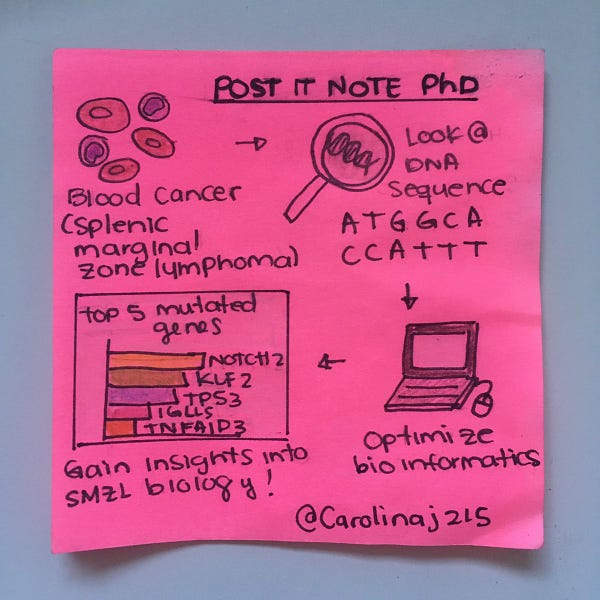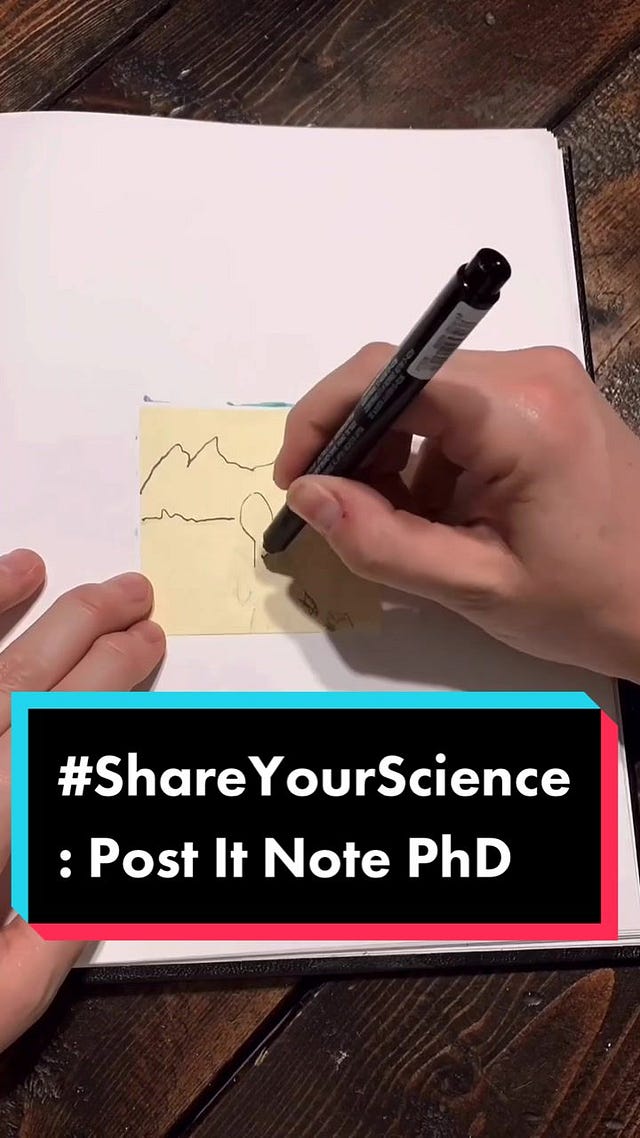#2: Sticky Note Science
Visual knowledge translation; dealing with discomfort during engagement; accessing articles when you are outside academia
Welcome back to Campfire Notebook, where I share blogs, bits and bobs about engaging more people in research and sharing science better. In Issue 2, I talk about visual communication tools for knowledge translation, being uncomfortable with engagement, and getting your hands on scientific papers when you don’t work at a university.
Found in Knowledge Translation Blog
Using Sticky Notes to Share Science
If there's one thing I can achieve through my posts, it's that you are aware of the many more ways to #ShareYourScience beyond journal articles or conference presentations. One unique way of doing this is the sticky note challenge, where you have to communicate your research topic using only one sticky note. Let's check out some examples I've found below the cut, and then I'll show you how I took my own thesis and made it a #PostItNotePhD.
The #PostItNotePhD is a way to engage people outside of your research, taking the "turn your thesis into an elevator pitch" challenge into a written/visual product.
Example 1: Carolina Oquendo, a PhD student at the University of Southampton, who is studying cancer genomics.


I like Carolina's example because:
It uses visuals. They don't have to be fancy, or require art school techniques, but they are important to include for the reader. She pairs her words with the actions of what she does: searching for DNA like a detective, using a computer to analyze data.
It takes the reader through the steps of her logic. There's a disease, so I do X and Y, and the answers will tell me what areas other researchers or clinicians should focus on.
It includes her Twitter handle. If the image was ever taken off Twitter and shared on other platforms, you are still linked back to the author.
Example 2: Lauren Eades, a PhD student at the University of Leeds, who is studying how bone marrow is changed by peripheral artery disease (when the arteries are narrowed and reduce the blood flow to the arms and legs).


Lauren's sticky note summary uses the same principles as Carolina's, but adds colour, shading, and a touch of playful cartooning to the structures to make it really pop. How can you not want to read this and learn more about her work?
It seems like a useful tool to both communicate your work to a broader audience, as well as make you consider how to best summarize your work for a wider audience. So, I decided to give it a shot! Check out the video below of a time lapse creating a sticky note synopsis of my PhD:
I reviewed my abstract and made notes of key words that could be easily visualized. In my case, the “search for identity” led me to think of travel imagery and exploring uncharted territories. It took a few rough sketches once I saw a photo on Pinterest of a woman backpacking and looking ahead to get the feeling I wanted to convey. In total, probably 1-1.5 hours of work.
Afterwards, I can say it’s a challenging, yet worthwhile, exercise to improve your scientific communication skills. your office. Learning how to condense years and pages of work into a 3x3 piece of paper makes you think purposefully about word choice and presentation of concepts. What do you include to communicate the main message, but without cramming too much?
Did you try the PostItNotePhD? Comment below and let me know if and how it helped you to summarize and share your science!
#HowToDoPtEngagement
It’s important for researchers to know that engaging patients is absolutely rewarding, both personally and for the quality of the science itself, but it is not easy.
Aside from the practical considerations of organizing engagement in a System that can be variable in its support of engagement, a part we don’t speak about enough is how you will feel very uncomfortable at times.
Embrace it.
Lean into it.
Learn to sit together with your partners in the fire, and listen.
The best sort of people are those who create space for stories. They can sit with an uncomfortable story without minimizing it, interrupting, looking for the bright side, correcting the storyteller or running away. - Bird’s Eye View
It’s one of the most important skills you need for building more patient engagement into research. (And I agree, Sue - there ain’t nothing “soft” about these skills!)
#ShareYourScience
Dr. Witteman’s Twitter thread is an excellent discussion about accessing journal articles behind paywalls, as well as the underlying issue that has created this inequity.
There are also lists, such as this one, that share the various open access repositories, internet browser extensions, and other tricks to finding credible information for your research without paying $40 for each article.
Reading Rainbow
Sadly, I ran out of time on my library loan of Obama’s memoirs. And I was halfway through listening to it, argh!
Lucky for me, a book I requested on learning organizations did come in - and hey, when the new executive keeps mentioning a book, you know it’ll be on the exam.






